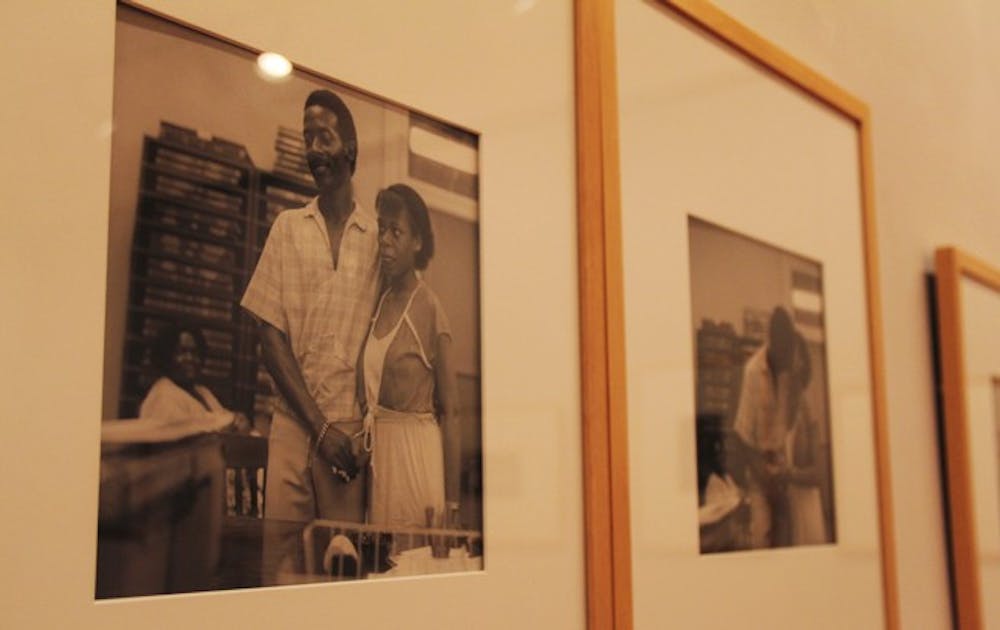What is it about Decatur County, Georgia—a small agricultural community just outside Atlanta—that fascinated the late Paul Kwilecki? Why would he spend a lifetime exclusively photographing one place? What kind of understanding does that depth of study bring?
The newest book—and corresponding exhibition—from the Center for Documentary Studies seeks to answer these questions. Just this Tuesday, in collaboration with the University of North Carolina Press, CDS published a 200-print collection and biographical study entitled One Place: Paul Kwilecki and Four Decades of Photographs from Decatur County, Georgia. Co-written by current CDS director Tom Rankin and former director Iris Tillman Hill, the book examines Kwilecki’s elegant, astute and thorough black-and-white photo documentation of both working- and merchant-class Georgians.
Courtney Reid-Eaton, the exhibition director at CDS, emphasized the breadth of Kwilecki’s study of Decatur County. She noted that though Kwilecki’s work was unusual for its size, it remains largely undiscovered.
“What’s exciting is that [Kwilecki’s collection] is kind of incomparable,” said Reid-Eaton. “Who else has spent forty years in one place?”
The collection is released as part of Documentary Arts and Culture, a series published by CDS and UNC Press that focuses on the history and traditions behind documentary culture. The last book in the series was Colors of Confinement, which presents photographer Bill Manbo’s documentation of the Japanese Internment Camp in Heart Mountain, Wyoming.
Kwilecki—who always worked alone—found that many artists balked at his choice to document a single community for such an extended period. In his essay “Decatur County,” which appears in One Place, Kwilecki defended his choice to exclusively document his home state.
“People confuse simple with small; they’re not the same thing,” writes Kwilecki in “Decatur County.” “There are no simple places or simple lives. [...] Life [in Decatur County] is like life everywhere, and I cannot think of a higher goal than understanding what we can of it.”
At times intense, and at others lighthearted, Kwilecki’s work captures the immense complexity of rural Georgian life. The artist shot everything from evangelical baptisms to courthouse weddings; from prisons to grocery stores; from hog killings to box factories. Kwilecki’s work focuses on scenes of everyday gatherings—moments in life that other photographers might gloss over. His portraits communicate the emotion embedded in subtle gestures: a logger adjusts his radio while driving his truck; a woman waits outside a courtroom; a minister prepares for a baptism during a revival meeting.
Although the collection spans several decades, Reid-Eaton noted, it doesn’t feel dated. She commented on Kwilecki’s ability to create narratives and aesthetics that transcend their historical context.
“Most of the images we show in the exhibition are from the 60s and 70s, but there are hundreds of images from every decade,” said Reid-Eaton. “Even then, it’s difficult to identify the changes. There’s a strange linked timelessness.”
The Kwilecki collection is currently held in the Archive for Documentary Arts, part of the David M. Rubenstein Rare Book and Manuscript Library. His photographs are available for viewing online through the Library’s digital portal. A curated selection of his photographs and facsimiles of some of his manuscript collection are part of a traveling exhibition as well.
Rankin, who originally met Kwilecki in 2001 and began One Place in collaboration with the artist, described how Kwilecki’s work achieves a sense of intimacy because the artist’s rapport with subjects allowed him to traverse racial and socioeconomic tensions in the South.
“I think when Paul drove up in someone’s yard or into a church gathering to photograph, he would have been identified immediately as a local, as a Kwilecki, and as someone his subjects respected,” Rankin wrote in an email. “I believe their respect would come from both his relative place of privilege as a white merchant and also from his quiet deference and sensitivity to those things he chose to photograph.”
Modesty, it seems, was one of Kwilecki’s defining characteristics. The artist’s own manuscripts and correspondences with other artists, which are included in the collection and exhibition, suggest altruistic motivation for his work.
“The object of the project is to provide Decatur Countians of future generations a document... to access the life from which they sprang,” reads a letter in the CDS exhibition. “If this sounds outrageous or presumptions or ambitious, I plead guilty as charged.”
The One Place exhibition is currently on display at CDS through August. Additionally, Rankin will give a talk and book signing for One Place on April 25 at CDS from 6-9 p.m. Copies of One Place are available in bookstores and through University of North Carolina Press.
Get The Chronicle straight to your inbox
Signup for our weekly newsletter. Cancel at any time.

